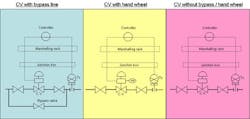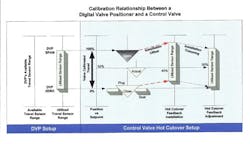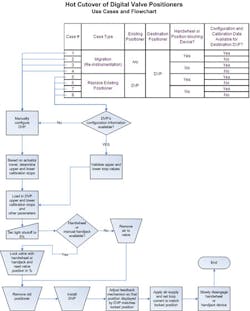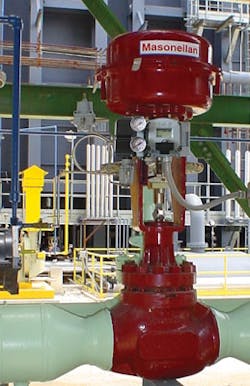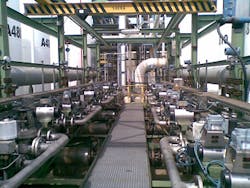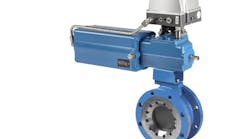Look around your home or office, and it’s obvious to see the world has become digital. In fact, digital is no longer a "buzz" word, because so many of the things around us have become digital. Do you refer to the radio in your car as a "digital radio?” No. You simply say "radio." Why? Because unless it is a classic car, it is assumed that the radio is digital, so the adjective is unnecessary. In fact, you may find yourself having to describe something as "analog" because that is no longer the norm.
A similar transformation is underway in process control, as a wide variety of new digital devices have been introduced in recent years, and a growing number of facilities have installed them. The transition is still a work in progress, however.
Some process control facilities have simply been a bit slower to adopt digital valve positioners, for example, as they seek to become more comfortable with this unfamiliar technology. Others have made the switch to digital devices, but have maintained an "analog mindset" and use the digital positioners as they did their analog predecessors. Returning to the car radio analogy, they have the latest Bluetooth-, satellite- and MP3-enabled system, but only use it to listen to a half-dozen local radio stations.
In either case, the result is the same. The status quo is maintained and technologies that could help plant operators save time, money and frustration while potentially improving product quality and enhancing safety, are either not adopted or are underutilized.
The first step in making the transition to digital valve positioners is understanding how they can be easily and cost-effectively implemented in a facility. This article will begin to bridge that gap by reviewing the various technologies available and highlighting the steps that should be taken to help ensure a successful transition. In addition, it will explain how plant operators can achieve what many consider to be a "mission impossible" – i.e., "hot cutover," or switching to a digital valve positioner while the process workflow continues uninterrupted.
Why move to digital valve technology?
Moving a process control plant from the world of analog control technology to that of digital control technology should be considered a permanent move. As this article will highlight, this permanent transition can provide significant benefits. But, as when considering any permanent move, plant personnel should ensure they have a clear understanding of the advantages and disadvantages before proceeding.
There is one very simple reason to consider going digital – to be competitive in today’s completely connected world. Processing plants, whether they produce power, raw materials, or finished products, are under constant pressure to maximize their operational excellence – a combination of profitability, plant efficiency, quality, and safety – in a tightly interconnected global economy. Digital valve positioners can help process plants meet these challenges by quickly and precisely giving them the information they need.
A poorly performing $3,000 control valve can cause significant losses because of shutdowns, lost production, reduced efficiency, and unsafe events. Such losses can be reduced with digital valve positioners because they have fewer moving components, are self-calibrating, and can provide diagnostic information that allows plant personnel to monitor valve health more easily. The outcome is improved control valve reliability, repeatable and sustainable performance, and detection of valve degradation before it impacts the process and while it is more easily corrected.
Digital valve positioning technologies: The options
Digital valve positioners (DVPs) can be divided into two categories: hybrid and fully digital.
Hybrid positioners use an analog signal (current) as a command signal while superimposing over that signal a frequency that allows for bi-directional communications. The HART Protocol is one example of a hybrid protocol.
In fully digital implementations, the command signal is provided in a binary form that is coded and decoded by a communication protocol. The FOUNDATION Fieldbus and Profibus PA protocols are examples of fully digital technologies for DVPs.
Hybrid positioners: The pros and cons
Hybrid DVPs offer several benefits for end-users who want to get their feet wet with digital technology without diving all the way in.
Implementing hybrid positioners is less disruptive than implementing fully digital devices because existing assets and infrastructure, such as the controller, cabinets and wiring, are retained. End users can quickly benefit from increased uptime and reliability with less engineering effort and a smaller capital investment.
Sustainability is another key advantage of hybrid installations because what controls the valve – the analog signal – is unchanged, and that familiarity means less additional training is required in order to troubleshoot, retrofit or replace the DVP.
Along the same lines, unlike an analog positioner, a DVP can guide the end-user in the setup and troubleshooting processes because it provides continuous information about its condition. As a result, less time is spent guessing what could be causing a problem, and the team can more quickly move on to resolving the problem.
On the minus side, hybrid technology will eventually become passé, so it is not a matter of whether the transition to fully digital devices will be made, but when.
Fully digital: The advantages and disadvantages
A fully digital implementation requires a complete replacement of the process controllers because the control signal to the DVP is no longer analog, but strictly digital. Upgrading to fully digital is, therefore, a bigger leap, but can also bring additional benefits.
The key advantage of a fully digital DVP implementation is that information moves seamlessly back and forth on the communication bus. In a hybrid system, information only travels between the positioner and the controller. In a fully digital implementation, it also travels between devices. As a result, the information can be used by all assets within the control structure, helping make process control smart and robust.
This complete and unobstructed view of the process and control system assets is one reason that designers of greenfield (or new construction) projects consider fully digital systems. In a hybrid installation, each valve is wired separately and each wire must be individually tested during the commissioning process. With potentially hundreds of valves in a facility, that process can be extremely time-consuming. In a fully digital implementation, however, several control valves can feed off of a main communication trunk, so there is only one test setup required to test several valves. The commissioning process is streamlined and the facility is up and running sooner.
In addition, a completely digital implementation enables predictive maintenance. According to an ARC Advisory Group study, "The real value of fieldbus is Operating Expenditure (OpEx) related rather than Capital Expenditure (CapEx) related. End-users have reported that predictive maintenance is the single largest savings resulting from the use of fieldbus." ("Fieldbus Solutions in the Process Industries Worldwide Outlook," Paula Hollywood, 2007)
This makes sense when you consider that control valves are a contributor to plant efficiency and make up a large portion of a facility’s maintenance budget. A fully digital DVP can provide alerts and key valve health indicators, allowing plant personnel to plan ahead using actionable information.
These are powerful advantages, but they do come with additional challenges. The disadvantage of a fully digital positioner is that it is completely digital. The operator must, therefore, understand the ramifications of bytes and bits. He or she does not need to know what "111101010" stands for in order to make a DVP work with the control loop, but does need additional software and computer skills to set up and commission a fully digital device because it is software that enables communication between the DVP and the other digital assets. If a digital positioner is not properly set up and integrated with the other assets, it will not be able to respond to a command signal.
As a result, there are more parameters to understand and to set up properly. On average, a fully digital DVP has 500 parameters with an average of four possible settings for each parameter – or 2,000 possible combinations. In contrast, a typical hybrid device (with HART communication) has 120 parameters with an average of three choices per parameter – just 360 possible combinations. In other words, setting up a fully digital DVP is a more complex process, and while it is not rocket science, it does require proper training.
Making the move: Going digital
With adequate preparation, the move to digital technology can be completed successfully while the process is running (online) or during a shutdown (offline). A hybrid implementation can be done with the existing control system in place, while a fully digital situation requires installation of a completely new control system that is capable of digital communication, such as FOUNDATION Fieldbus or PROFIBUS.
Situation 1: Offline – While the process is down or the valve is isolated
When installing a hybrid DVP (4-20mA with HART), an important consideration is whether or not there is an existing 4-20mA signal available at or near the valve. Very little engineering is required if there is an existing signal going to a current-to-pressure-converter (I/P converter) or an electro-pneumatic positioner. In most cases, the engineering involved will be related to management of change (MOC) because the DVP will replace the analog positioner using the existing wiring.
If the process is running but the valve can be isolated (bypassed), it is best to take advantage of remote digital communication. Once the mechanical installation has been completed, personnel can move to a safe area to carry out the calibration, preventing unnecessary exposure to a potentially hazardous process environment.
In a fully digital implementation, additional engineering will be required prior to the installation, as the DVP will be digitally integrated with the process control system. This engineering typically consists of:
- Determining whether there are available addresses for the DVP on the communication segment. Every device on a segment must have its own digital address so that it can exchange information with each of the other devices on the segment.
- Quantifying the total execution time of the loop. In most control loops, one second is needed to process the measured variable and provide a command signal to a final control element. But some loops, such as flow and pressure, require quicker execution. In these cases, adding multiple DVPs may not provide for robust control.
- Identifying the function block within the DVP that will be necessary for each process control loop. For instance, it is necessary to determine whether the process PID will reside in the DVP or elsewhere on the communication segment. If the PID will reside in the DVP, the parameters for process control must be carefully reviewed and determined in advance.
Situation 2: Online – While the process is running (a.k.a. "hot cutover")
If the process cannot be shut down, it is still relatively easy to replace an analog positioner with a digital device. This technique is known as "hot cutover" or "online installation."
Many plant operators still see hot cutover as "mission impossible," and it is indeed so when replacing one traditional analog positioner with another. Several refineries and petrochemical plants have, however, successfully replaced analog positioners with hybrid devices while the plant was in operation, avoiding significant losses in production that would have resulted from a plant shutdown.
End-users have also successfully completed "mission impossible 2" – migrating from a completely pneumatic control system to a fully digital system while the plant was running. The key to this capability is that, when working with DVPs, little or no mechanical adjustment is necessary and the zero and span can be preset. This allows the replacement of a pneumatic positioner with a DVP without moving the valve for calibration purposes.
In such cases, the valve must be isolated, be locked in its existing position, or remain in its failsafe (open or closed) position. It is, therefore, recommended that the DVP be configured and calibrated before work begins at the valve, thus minimizing the amount of time that the valve will be isolated or manually locked in position.
What makes hot cutover possible is that a DVP’s zero and span are not mechanical. There are no screws to turn, beams to balance or springs to adjust when setting the starting and ending points that correspond to 0 percent to 100 percent travel. The zero and span are set digitally and the DVP’s feedback mechanism is adjusted to match the actual position of the valve. For example, if the mechanical position of the valve reads 25 percent after the zero and span have been set, the DVP’s feedback system can be easily adjusted so that it also reports out 25 percent.
Figure 2 illustrates the relationship between a DVP’s digital feedback and the true mechanical position of a valve. A DVP has an available range to measure a displacement of the valve. A portion of that available range will be utilized by the DVP.
Of course, the success of any mission also hinges on having the right tools and a solid execution plan. The flowchart in Figure 3 identifies the essential questions to be answered, the key steps in the process, and the tools that will be required to upgrade to digital technology while the process is "live."
Considerations for a successful move to digital devices
Whether upgrading to hybrid or fully digital technology, the following are some key considerations to keep in mind.
Wiring/Power: An analog positioner requires 2-3 Vdc, while a DVP can require up to 12 Vdc. Not all legacy control systems are capable of providing a 4-20mA command signal to a DVP that requires 12 Vdc. This power shortage is even more likely to occur in split-ranged control valve applications in which a DVP is replacing two analog positioners connected in series.
When specifying a DVP, and before removing the old analog positioner, plant personnel should verify the maximum load that the controller’s output is capable of and choose the DVP accordingly. If the voltage is still insufficient, particularly when installing two positioners in series, a signal conditioner with more voltage will be necessary.
In a fully digital implementation, proper wiring is essential because it greatly affects the quality of the digital signal. If the wiring is not properly grounded and terminated, signal quality will be compromised and communication between devices will be slow, affecting every device on the communication bus.
Number of DVPs: The greater the number of DVPs that are installed on the same wire, the greater the risk that multiple control valves will be taken out of service if power is lost to that bus or if the main trunk for that bus is broken. A good rule of thumb is to have no more than three valves per segment and, in key applications and extremely fast process control loops, to have only one valve.
Training/Personnel: When planning an upgrade to a fully digital system, plant personnel must allocate adequate time and resources for training the in-house team. Otherwise, once the installation has been completed and the vendor has moved on to the next project, they may quickly realize that they do not have the knowledge required to support and maintain the new system. It is, therefore, imperative that a detailed training program be included in the upgrade plan and that the program include ongoing training until the team is comfortable working with the devices.
Most DVP manufacturers offer product training programs, and excellent courses are available through a variety of colleges and through the Instrument Society of America (ISA). These programs teach attendees how to mount and set up the DVP, how to commission the DVP using a handheld device, and how to troubleshoot.
The training required to work with hybrid installations is more straightforward, as the command signal is similar to that of an analog device and special system configurations are not necessary to make the valve work with the control system.
Support Tools: A basic 4-20 mA signal generator and voltmeter are not sufficient to support a hybrid or fully digital installation with DVPs – particularly a fully digital installation.
While some 4-20mA HART positioners can be set up locally at the device when equipped with an LCD or local buttons for setup and calibration, others require software with a HART modem or a portable handheld calibrator capable of communicating with the DVP. The setup process, thanks to the digital positioners’ user-friendly interfaces and ability to provide troubleshooting information is significantly streamlined compared to that associated with setting up an analog positioner.
A fully digital DVP will also require a special power supply, a handheld device or computer with digital communication, a modem, software, and communication analyzers. These tools are readily available, and it is only a matter of planning and budgeting for such tools when developing the project scope.
Loop Tuning/Control System Adjustments: Imagine a four-cylinder engine in a midsize car. You have driven this car for years, and you have the habit of putting a certain amount of pressure on the gas pedal when passing another car or starting after a complete stop. Now, put a more powerful and efficient eight-cylinder engine in that same car. There is a good chance that, if you hit the gas pedal the same way, the tires will screech. Worse, you might bump into the car in front of you.
The same theory applies when retrofitting a DVP on a control valve that is already installed in a plant. The old analog positioner may not respond until the signal changes by 1 percent or 2 percent or even more, and it may not be as quick and accurate when positioning the valve. But the loop is tuned and optimized based on those performance characteristics. In contrast, a DVP, with its precise feedback sensor, fewer mechanical moving parts, and fast control algorithm, may respond to a command signal as low as 0.1 percent and move the valve much faster and with greater accuracy. The control valve’s dynamic response has dramatically changed and, as a result, the loop tuning is likely too aggressive for this new control valve behavior.
The worst response to this problem would be to detune the DVP and make it perform like a four-cylinder engine. Doing so would defeat one of the purposes of moving to a digital device – greater plant performance. The best practice is to involve the process control engineer when moving from an analog device to a digital one and work as a team to maximize the control valve’s overall performance.
Putting the DVP’s data to work
As mentioned earlier, end-users have reported that the ability to conduct predictive maintenance is the single biggest contributor to the savings that result from the use of fieldbus. The key is a DVP’s ability to provide easy access to diagnostic information.
In hybrid installations on older control systems, the use of wireless technology can cost-effectively link the DVP and the asset monitoring tools. Newer controllers can communicate with hybrid DVPs without the intermediary of wireless technology. Fully digital DVPs can literally put terabytes of process information at plant personnel’s fingertips.
The data is most valuable, however, when it is delivered with actionable information that is then put to use. When upgrading to digital valve technology, facilities must also invest in the tools – such as plant asset management software and online valve monitoring tools – needed to capture, consolidate and present the information in an actionable format.
Plant personnel must also adapt their workflows (and often shift their mindsets) to embrace these new tools. Too often, digital devices are installed and then gather dust as habits remain unchanged and the available data is not accessed and acted upon.
he world around us has become digital. In so many ways, that emigration has made us more productive and efficient, made our day-to-day lives easier, and made the things we use every day more powerful, reliable and user-friendly. The same thing could happen in the process control world, thanks to today’s digital valve positioning technology. All it takes is a bit of planning and a willingness to start the journey.
Sandro Esposito is global marketing manager for digital and SMART products at GE Energy. A 17-year veteran of the control valve and process automation industries, he has extensive experience with control valve diagnostics and system integration. He has been granted several patents related to digital valve positioners. He graduated from Ahuntsic College in Montreal with a degree in instrumentation and process controls. Reach him at [email protected] or 281 671-1683.

